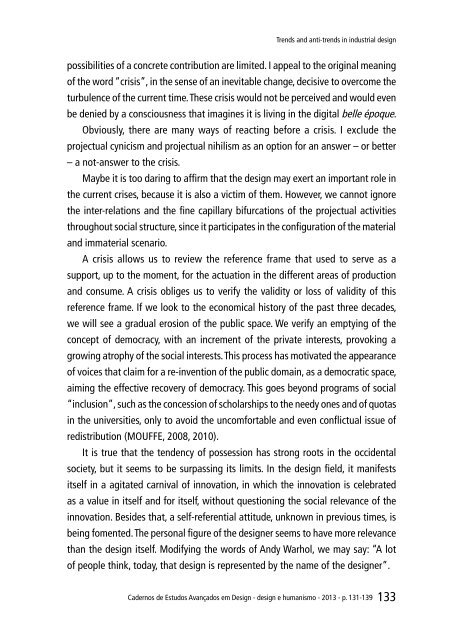o_19po8js951tvs1r0t1r8s4bb1vpla.pdf
You also want an ePaper? Increase the reach of your titles
YUMPU automatically turns print PDFs into web optimized ePapers that Google loves.
Trends and anti-trends in industrial design<br />
possibilities of a concrete contribution are limited. I appeal to the original meaning<br />
of the word “crisis”, in the sense of an inevitable change, decisive to overcome the<br />
turbulence of the current time. These crisis would not be perceived and would even<br />
be denied by a consciousness that imagines it is living in the digital belle époque.<br />
Obviously, there are many ways of reacting before a crisis. I exclude the<br />
projectual cynicism and projectual nihilism as an option for an answer – or better<br />
– a not-answer to the crisis.<br />
Maybe it is too daring to affirm that the design may exert an important role in<br />
the current crises, because it is also a victim of them. However, we cannot ignore<br />
the inter-relations and the fine capillary bifurcations of the projectual activities<br />
throughout social structure, since it participates in the configuration of the material<br />
and immaterial scenario.<br />
A crisis allows us to review the reference frame that used to serve as a<br />
support, up to the moment, for the actuation in the different areas of production<br />
and consume. A crisis obliges us to verify the validity or loss of validity of this<br />
reference frame. If we look to the economical history of the past three decades,<br />
we will see a gradual erosion of the public space. We verify an emptying of the<br />
concept of democracy, with an increment of the private interests, provoking a<br />
growing atrophy of the social interests. This process has motivated the appearance<br />
of voices that claim for a re-invention of the public domain, as a democratic space,<br />
aiming the effective recovery of democracy. This goes beyond programs of social<br />
“inclusion”, such as the concession of scholarships to the needy ones and of quotas<br />
in the universities, only to avoid the uncomfortable and even conflictual issue of<br />
redistribution (MOUFFE, 2008, 2010).<br />
It is true that the tendency of possession has strong roots in the occidental<br />
society, but it seems to be surpassing its limits. In the design field, it manifests<br />
itself in a agitated carnival of innovation, in which the innovation is celebrated<br />
as a value in itself and for itself, without questioning the social relevance of the<br />
innovation. Besides that, a self-referential attitude, unknown in previous times, is<br />
being fomented. The personal figure of the designer seems to have more relevance<br />
than the design itself. Modifying the words of Andy Warhol, we may say: “A lot<br />
of people think, today, that design is represented by the name of the designer”.<br />
Cadernos de Estudos Avançados em Design - design e humanismo - 2013 - p. 131-139<br />
133



